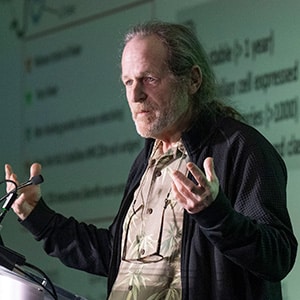Most major scientific breakthroughs result from deep exploration of simple, yet powerful questions. For immunologists, one such question is: How do T cells recognize and respond to disease? During the second day of AACR IO, held February 23-26, keynote lectures by James Heath, PhD, FAACR, and K. Christopher Garcia, PhD, FAACR, explored this question from two distinct yet complementary perspectives. Their presentations focused on cracking the code of T-cell biology and building T-cell receptor (TCR) libraries that help translate T cells’ native language into something we can understand and use to help patients.
Heath, president and professor at the Institute for Systems Biology, highlighted efforts to create vast TCR libraries that improve our understanding of how T cells recognize antigens. This approach transforms a chaotic matrix of T cell-antigen interactions into something decipherable, enabling researchers to craft more precise immune responses.
Garcia, Younger Family Professor and professor of structural biology at Stanford University, meanwhile, focused on how T cells interpret signals from their environment and how reengineering cytokine signaling pathways can refine immune responses. By designing new signaling mechanisms, he aims to give scientists a toolkit to guide immune activity with greater precision.
Heath’s and Garcia’s efforts represent two sides of the same coin—uncovering not just how T cells see threats, but also how they respond to various alarms. By constructing comprehensive TCR libraries and reengineering cytokine signaling pathways, they are slowly but surely gaining ground in understanding the complexities of T-cell biology to create a more predictable and controllable immune response.
Building TCR Libraries: Expanding Our Understanding of Antigen Recognition and Response
T cells have two primary types, each with distinct roles in the immune response. CD8 T cells recognize antigens presented by human leukocyte antigen (HLA) class I molecules and are responsible for directly killing infected or cancerous cells. CD4 T cells recognize antigens presented by HLA class II molecules and, while they can kill, they are more involved in orchestrating broader immune responses and supporting long-term immune memory.

Engineered TCR therapies, the first of which received accelerated approval for sarcoma last year, often rely on a single TCR targeting a single antigen. This narrow approach limits patient eligibility, especially since many therapies focus on common HLA variants found predominantly in European populations. “When you have such a potent therapy but such a limited demographic that can actually [use] the therapy, we should think deeply about how we can expand the library of T-cell receptors,” Heath emphasized.
Relying on a single TCR also increases the risk of immune evasion, as tumors can lose the critical HLAs to avoid detection.
To overcome these limitations, Heath’s lab developed a scalable TCR discovery pipeline designed to support the creation of off-the-shelf TCR libraries that cover a broad range of TCR specificities, including both HLA class I- and class II-restricted antigens.
Class II-restricted TCRs, though crucial for long-term immune surveillance and durable antitumor responses, have proven harder to characterize and target therapeutically, for a variety of reasons. “The validation of class II-restricted TCRs is actually a pretty exhaustive process,” Heath noted. “Only through the full picture do you actually get a TCR that I think you can go forward with into the clinic.”
Heath’s computational modeling also suggested differences between CD4 and CD8 TCRs and the rules governing each. “We’re just beginning to understand this a little bit,” Heath admitted. “But it does reflect that there are molecular differences across these different classes of TCRs that [may] have to do with what dictates the CD4 or CD8 identity, but maybe even more than that.”
At least for some cancers, Heath believes off-the-shelf libraries of TCRs for patients is possible. “I think a modest library size of 10 TCRs, including both class I- and class II-restricted antigens and coupled with an efficient manufacturing approach such as the precision CRISPR-guided knock-in instead of viral methods, makes something like that tractable. And I don’t think that you could have said that a few years ago.”
Heath is determined to turn this vision into reality, by continuing to refine and improve these strategies to make T-cell therapies more adaptable, scalable, and accessible for cancer patients.
Engineering Cytokine Signaling to Rewire T-cell Responses
While Heath focused on TCR recognition, Garcia explored how T cells interpret and act on cues from cytokines—key signaling molecules that direct immune responses. Cytokines can drive T cells in many directions, and Garcia sees this flexibility as an opportunity.
“I look at cytokine signaling the way an artist looks at a palette of colors. You have your primary colors, but you can mix them and match them in many ways,” Garcia explained.
Indulging in his artistic aspirations, Garcia created an orthogonal ligand-receptor system, essentially a way to create private communication channels to deliver cytokine messages exclusively to engineered T cells. In its simplest form, this involves modifying a cytokine, like IL-2, and its receptor so the engineered IL-2 only binds to its matching engineered receptor. This ensures only the modified T cells receive the signal, allowing for concerted but controlled responses.

Garcia took this further by customizing how signals are transmitted inside T cells. Through the inclusion of additional cytokine signaling complexes into the intracellular domains of cytokine receptors, he demonstrated the ability to control what signals are relayed to the rest of the T cell after the cytokine binds to its receptor. This allows signals from extracellular cytokines, like IL-2, to trigger not only its typical intracellular signals but also new intracellular signals, giving scientists the ability to fine-tune T-cell responses.
This approach led to surprising results, as certain cytokine chimeras were able to endow individual T cells with properties that are usually mutually exclusive to distinct subsets of T cells, or even other immune cells. By customizing the intracellular signaling domain with a component associated with myeloid cells, one chimera granted T cells myeloid-like properties, including the ability to phagocytose bacteria. This, Garcia stated, should prompt us to recalibrate our views about the range of functions and phenotypes T cells can acquire through synthetic manipulations.
Garcia also introduced a “trikine,” a hybrid cytokine with a linker that brings the IL-2 and IL-21 receptors into close proximity, allowing both to be activated as part of the same signaling complex. This coordinated activation balances signals that drive both T-cell proliferation and longevity while avoiding toxicities that occurred when mice were treated with the natural versions of IL-2 and IL-21 in combination.
“The future of cytokine therapy in immunotherapy will be about rebalancing cytokines and fundamentally rewiring the signaling pathways,” Garcia suggested.
A Future of Immune Fluency
Heath’s vision of an off-the-shelf library of TCRs—covering both class I- and class II-restricted antigens—opens the door to scalable, broadly applicable T cell therapies. Thanks to advances like CRISPR-guided knock-in technology, this once-abstract idea now edges closer to clinical reality.
Garcia, meanwhile, is pushing the boundaries of how we can manipulate T-cell behavior. His work doesn’t just fine-tune existing pathways—it creates entirely new modes of immune behavior, reshaping how T cells proliferate, persist, and function. Innovations like the trikine offer the possibility to not only overcome previous toxicity issues but also to unleash new T-cell capabilities by rebalancing and rewiring their immune signaling.
Together, these approaches may represent the beginnings of a new era of immunotherapy—one where we can select the right TCRs for each patient and then program their T cells to behave in ways nature never intended but cancer never saw coming.
The post From Cracking Codes to Creating Cures: Leveraging Libraries to Learn the Language of T Cells appeared first on American Association for Cancer Research (AACR).



